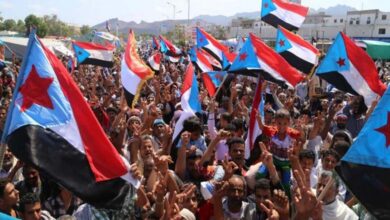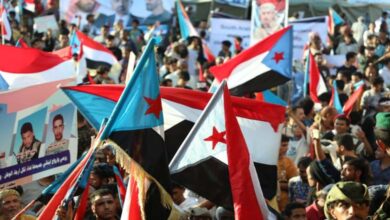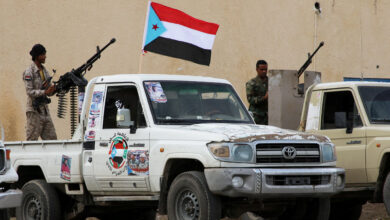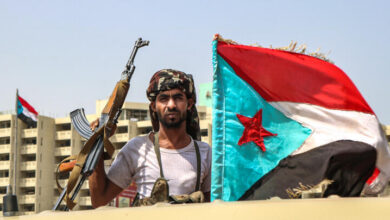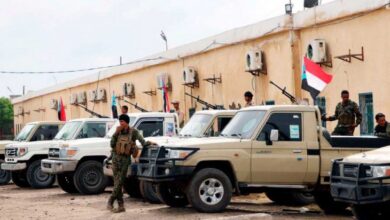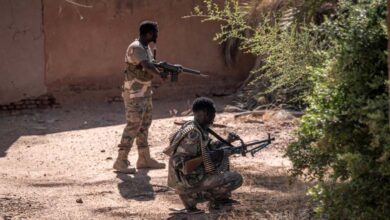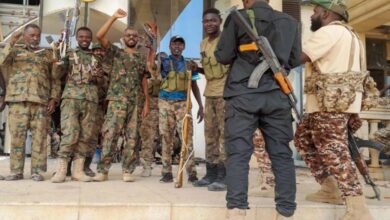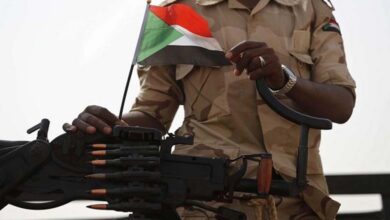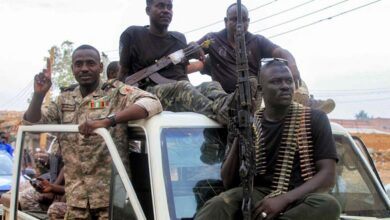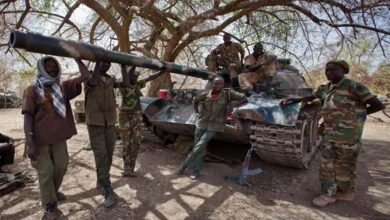Military formations affiliated with the Muslim Brotherhood fight alongside the Sudanese army
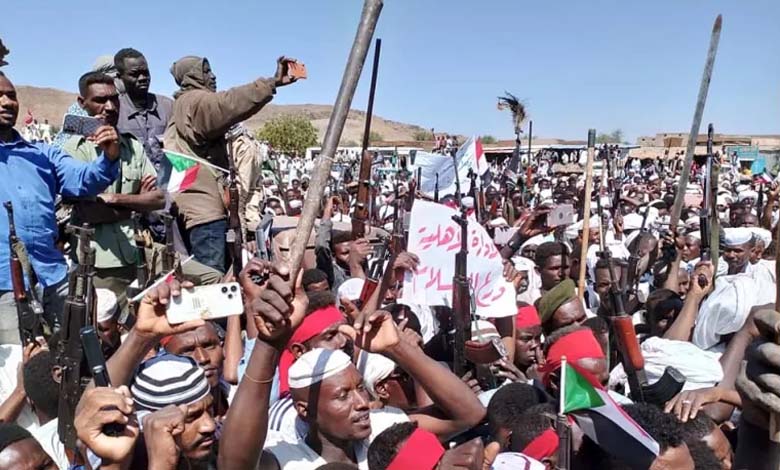
The fierce war raging in Sudan since April of last year has opened the door for organized military formations and other popular voluntary groups to engage in combat alongside the army against the Rapid Support Forces, aiming to force them to retreat from their positions in Khartoum, Darfur, Al-Jazirah, and Kordofan.
Yasser Al-Atta, assistant to the army’s commander-in-chief, spoke about meetings he held with some of the groups formed within the so-called “Popular Resistance” to defeat the Rapid Support Forces. He mentioned groups such as the “Bara’a Battalion” and “The Angry,” and also noted the formation of the High Committee for Popular Resistance in the Khartoum state.
In many states where the war has not spread, it has become common to see hundreds of volunteers undergoing military training to join the Popular Resistance and confront any potential movement by the Rapid Support Forces.
In addition to weapons training, some voluntary groups have conducted joint maneuvers with the army in its controlled areas. Some of these maneuvers took place in cities such as Shandi on the border of the Nile state with Khartoum, Dongola in the Northern state, and Halfa Al Jadida in the east of the country, according to participants from the Popular Resistance who spoke to Al Jazeera.
New Brigades
From the Popular Resistance emerged special units, including the “Intelligence of the Resistance in Old Omdurman,” a city that is a significant part of the capital and is shared in control between the army and the Rapid Support Forces.
According to information obtained from one of its members named Ahmed, who requested only his first name to be mentioned, this group comprises selected personnel tasked with gathering information about the locations of the Rapid Support Forces, monitoring their movements, and assisting military units in targeting their positions with airstrikes and artillery.
Additionally, other brigades and groups have emerged, trained, and integrated into the army in various areas of the capital. Meanwhile, a large group of Islamists loyal to the former regime operates within the “Bara’a ibn Malik Battalion.”
Al-Atta does not favor classifications that indicate loyalty to one group or another. He says that within the army, like other citizens defending their country against border-crossing militias, everyone is a citizen defending their homeland under the army’s leadership.
Bara’a ibn Malik
After weeks of war, the Bara’a ibn Malik Battalion was announced to be transformed into a brigade following the joining of a large number of fighters who have made the armored forces south of Khartoum one of the main military bases from which to plan the fight against the Rapid Support Forces alongside the army.
Hundreds of Popular Defense Forces fighters have rallied under this brigade, a military formation that was active during the rule of ousted President Omar al-Bashir and played a significant role during the government’s war against the People’s Army in southern Sudan.
Shortly after the war started, Abu Zeid, the commander of the Bara’a Brigade, emerged. He is one of the well-known youths affiliated with the Sudanese Islamic movement from within the armored forces. Videos of battles produced by the battalion began to appear, disseminated on social media platforms accompanied by known Islamic chants and songs.
The Bara’a ibn Malik Brigade is believed by political analyst Mohamed Idris, speaking to Al Jazeera, to be part of the shadow brigades mentioned by Ali Osman Mohamed Taha, deputy to ousted President Omar al-Bashir, in 2018.
This brigade possesses a wide range of weapons and elements prepared to fight under various conditions, according to Idris. It is rumored that “some of its elements are tasked with directing drones.”
The Solid Structure
Fighting alongside the Sudanese army is also the “Solid Structure Battalion,” one of the largest former battalions in the Popular Defense Forces that was dissolved in 2020. It includes elements from the former National Security and Intelligence Service who left their positions after the fall of the al-Bashir regime in 2019.
A source within the Popular Defense Forces told Al Jazeera that “this battalion underwent advanced training on various weapons, and its members are currently stationed alongside the army in several locations in the three capital cities.”
Among the participants from Islamist groups affiliated with the former regime who joined the army, according to the former source within the Popular Defense Forces, is the “People’s Security” group, which during al-Bashir‘s rule carried out high-level security missions in secrecy.
Angry Without Borders
Also joining the army are members of the “Angry Without Borders” group, one of the youth groups aged between 17 and 24, which emerged strongly during the popular protests against the al-Bashir regime. They were known for confronting security forces and police at the forefront of protest lines. They continued their resistance against the former Transitional Military Council, and after the coup by the army commander in October 2021.
A number of “Angry” cadre joined the mobilization camps and underwent training in army units, especially the armored forces. Others are stationed in the Engineering Corps in Omdurman and the Air Force camp.
New Brigades
Investigations have revealed preparations for the announcement of a brigade named “Al-Matmoura” in the state of Gedaref in the east of the country, alongside other groups in other localities in the state that have been trained and armed with light weapons.
Testimonies have also shown the preparation of other groups in the localities of Rabak and Al-Salam in the state of White Nile to the south, as well as at the mobilization camp for popular resistance in Kassala, Arroma, and Halfa Al Jadida in the east of Sudan.
These preparations are being supervised directly by local government authorities, in coordination with the military command in the region.
In the north of the country, several cities are witnessing formations of popular resistance, in addition to groups deployed at Abu Sharif camp in Kosti city in the White Nile state, Shendi in the River Nile state, and others in North Kordofan and Sennar, as well as cities in West Kordofan, all of which have begun their military and training activities.
The government of Khartoum state announced last weekend the start of activities of the Higher Committee for Popular Resistance in the state, and opened the door for joining and arming in areas controlled by the army.
An army officer, who requested that his name and rank be withheld, says that “popular resistance groups do not engage in combat actions or participate in battles as they have not received complete military training. They instead secure some neighborhoods and sites, and conduct patrols to protect against thieves and monitor suspicious activities.”
In contrast, one of the mobilized within the popular resistance currently in one of the army camps in Khartoum told Al Jazeera Net that he participates with soldiers in combat operations and extensive patrols.
A former officer of the Armed Forces, Fathi Ahmed, in an interview with Al Jazeera Net, describes the current experience of popular resistance as failed due to its ethnic and regional foundations, pointing out the weakness of training, equipment, and armament of those supposed to work in popular resistance, as well as the formulation of ineffective plans to use them in a battle he sees as unequal against highly trained soldiers equipped with heavy and modern weapons.
Resistance Weapons
In areas under army control, each neighborhood is headed by a high-level committee of popular resistance, alongside a committee in each neighborhood headed by a person tasked with listing volunteers and submitting the list to the local or regional army committee, so they can join the training camp or be armed after providing proof of their training and qualification to use weapons.
The neighborhood official, according to monitoring and information from one of the mobilized in Khartoum, oversees the distribution of weapons and ammunition in coordination with military intelligence elements of the army.
The mobilized person receives a single weapon, a Kalashnikov assault rifle, and three additional magazines filled with ammunition, registered with a serial number after filling out a form containing their personal information. He confirmed that no heavy weapons, machine guns, cannons, and rocket launchers have been distributed, contrary to what is being announced.


